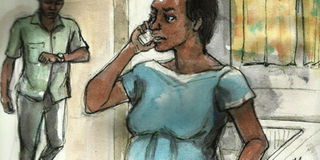Death from a fibroid operation

The Medical and Dental Practitioners Act 1998, is one of the laws of Uganda. This law mandates the establishment of the Medical and Dental Practitioners Council whose functions include, but are not limited to: Maintenance and enforcement of professional medical and dental ethics, supervision of medical and dental practice at all levels, disciplinary control over medical and dental practitioners, protect society from abuse of medical and dental care and register medical and dental practitioners. The council also has the mandate to deregister a member found guilty of professional misconduct.
One of the functions of the council is to hold an inquiry when it receives an allegation, which if proved, would constitute misconduct on the part of the registered practitioner.
Death of Ayiru
In line with this function, the council, held an inquiry into the death of Ms Mercy Ayiru that occurred on October 14, 2010, at Women’s Hospital International and Fertility Centre. The deceased died during a botched operation for a uterine fibroid using laparoscopic surgery.
Investigations
The hospital is owned and operated by Dr Tamale Ssali who told the council that he is a private consultant practising Obstetrics and Gynaecology and the principal director of the facility. He took full responsibility for all employees, local or foreign, at the facility as well as the patients. He admitted that it was his responsibility to see every patient coming to the facility for whatever reason, including those in need of specialised surgery.
Ms Ayiru was referred to Dr Ssali by a doctor from International Hospital Kampala with a diagnosis of uterine fibroids and at was Dr Ssali’s decision to engage a foreign specialist to carry out laparoscopic surgery.
He, however, did not tell the council how he arrived at this decision and the diagnosis of infertility. What is not in question is that he reportedly charged Shs8m for the procedure.
Dr Parker hired
Dr Ssali hired Dr Rafique Parkar, a registered practitioner in Kenya, to carry out the surgery. Dr Parkar was not, however, registered to practice medicine or surgery in Uganda as the law requires. Dr Ssali thought that Dr Parkar was free to work in Uganda under the East African Protocol. Ignorance of the law is no defence and Dr Ssali accepted full responsibility for this anomaly.
Ms Ayiru was advised to come for admission at the hospital on October 14, 2010 at 6pm as the operation was scheduled for the following day at 8:30am. On October 13, Ms Ayiru received a call from the hospital and she was told that the operation had been moved forward and she was therefore requested to report for the surgery the following day in the morning, the day of the operation.
Operation goes bad
She duly reported for the operation as rescheduled and between 8:30am and 9:00 am her blood pressure and was taken and found to be high.
The medical experts asked her to relax and to the anaesthetist she appeared apprehensive since she had just come in.
The anaesthetist told the chief surgeon about the patient’s elevated blood pressure but “the doctor just kept quiet”. He told the Council that ordinarily they would have considered cancelling the operation but he went ahead with the operation despite the fact that the patient had not been adequately prepared as “the doctors tend to drive the anaesthetist.
The patient was taken to theatre and according to the statement submitted by Dr Parkar the members of the operating team were Dr Ssali, Dr Ruth Kavuma, the anaesthetist Christopher Kirunda and four other theatre staff. Dr Parkar told the Inquiry that high blood pressure is not a contra-indication to laparoscopic surgery and that, in any case, the onus to monitor the blood pressure was on the anaesthetist.
According to the anaesthetist the patient was put on the operating table and a tube inserted into her airways.
The surgeon then made an incision into the abdomen and distended the abdomen with carbon dioxide. The patient’s blood pressure however shot up to 190/110 and the heart rate also increased and the oxygen concentration decreased.
That is when the alarm on the machine monitoring the patient’s vitals went off. According to him, the operation went ahead even when the machine was making alarms “because everything happened very fast”.
When the machine kept making noise, he stopped the anaesthetic gases and started cardio-pulmonary resuscitation.
According to him, during that time, the two surgeons Dr Parkar and Dr Ssali were in theatre with him. The anaesthetist accepted that he was partly responsible for what went wrong during the operation.
According to the surgeon, Dr Parkar, the tube that was to be inserted in the patient’s airway was instead placed in the patient’s stomach and the evidence of this was the blood that was found in the stomach during the post-mortem examination. The surgeon denied having anything to do with the death.
This article is based on a ruling that the Uganda Medical and Dental Council availed and submitted in an open Court of Law




